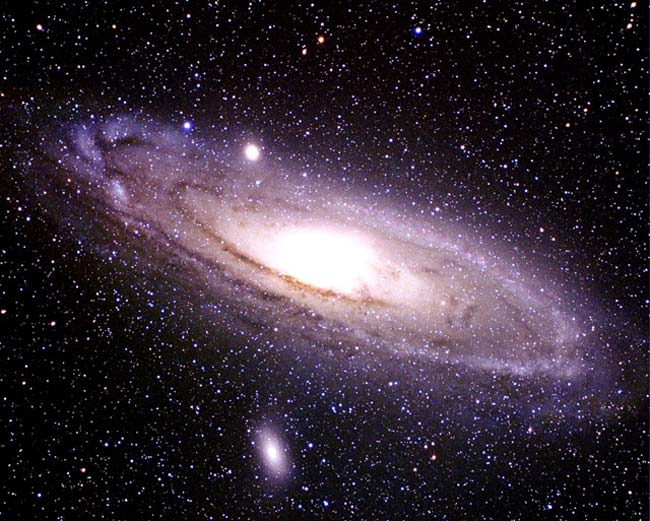
Astronomers have determined the density and speed of dark matter in our corner of the universe.
The finding helps bring dark matter out of the realm of the hypothetical and places scientists a few steps to closer figuring out what this invisible stuff that pervades the universe and holds galaxies together is made of. It also settles once and for all the question of which galaxy--our Milky Way or Andromeda--is more massive.
The winner: The Milky Way.
Dark matter is warm
Researchers used the Very Large Telescope in Chile to observe 12 dwarf galaxies as they orbited around our Milky Way. The researchers traced the satellite galaxies' movements in three dimensions. By doing so, they were able to weigh the galaxies very precisely and calculate how much dark matter is holding them together.
The findings showed that the galaxies contain about 400 times more dark matter than ordinary matter; it also showed that the dark matter particles cannot be packed together more tightly than the equivalent of 20 hydrogen atoms per cubic centimeter of space.
"It's important to note this stuff is not hydrogen atoms, it's just how much it weighs," said study team leader Gerry Gilmore from the University of Cambridge.
Get the Space.com Newsletter
Breaking space news, the latest updates on rocket launches, skywatching events and more!
This surprisingly low density means that the smallest possible volume of space that dark matter can occupy is a cube measuring 1,000 light years across with 30 million times the mass of the Sun.
"We never find smaller amounts of dark matter or more concentrated dark matter," Gilmore said.
Scientists think that large galaxies are built lego-style through the combination of these blocks of dark matter and the stars they contain.
By knowing the minimum volume that dark matter can occupy, the researchers were able to calculate other physical properties of dark matter. One of these properties was speed, which turned out to be about 6 miles per second (9km/s).
"That's about a million times faster than predictions," Gilmore said in a telephone interview.
The researchers also calculated dark matter's "temperature"--or at least, the temperature dark matter would have if it gave off heat like ordinary matter. One of the difficulties about studying dark matter, of course, is that it emits no light and gives off no radiation, including heat.
If dark matter were made of hydrogen atoms, it would have a temperature of about 18,000 degrees Fahrenheit (10,000 C)--or hotter than the surface of the Sun.
This temperature is much warmer than scientists had expected. Other theories predicted that dark matter particles were relatively sluggish and that their temperature might be as low as 1 degree Celsius.
The heavyweight champion
The research also settles an old debate among astronomers about which galaxy, our Milky Way or Andromeda, is more massive. The detailed study of the dwarf galaxies allowed the researchers to weigh our own galaxy more precisely than ever before.
"We are almost exactly twice as massive as Andromeda," Gilmore said.
The discovery was made by Mark Wilkinson, another team member in the study. Andromeda is still believed to be bigger and have many more stars than the Milky Way--possibly because it swallowed up a bunch of smaller galaxies--but it has slightly less dark matter.
What is it?
Scientists still have a long way to go before they figure out what dark matter is, but the new findings could help narrow the possibilities, Gilmore said.
The two most popular candidates for dark matter are hefty particles called supersymmetric particles and low-mass particles called axions. Supersymmetric particles are believed to be a family of particles that have masses ranging from hundreds to thousands of times that of an ordinary hydrogen atom.
Axions are believed to have a very small mass and to have been created in large quantities during the Big Bang. Gilmore said the new results seem to favor axions as making up dark matter, but it might also be that dark matter is made up of a variety of particles.
"There's no reason to think dark matter is made of just one sort of thing any more than ordinary matter is made of one sort of thing," Gilmore told SPACE.com. "But this is certainly telling us that the ordinary dark matter particle is more likely to be an axion than a super-symmetry particle."
The study will be detailed in a leading astrophysics journal in the next few weeks.
- Dark Matter: Hidden Mass Confounds Science, Inspires Revolutionary Theories
- Dark Matter Exposed: Animation Offers Clues to Cosmic Mystery
- The Milky Way: A Tourist's Guide
- Andromeda Galaxy 3 Times Bigger than Thought
Join our Space Forums to keep talking space on the latest missions, night sky and more! And if you have a news tip, correction or comment, let us know at: community@space.com.
Ker Than is a science writer and children's book author who joined Space.com as a Staff Writer from 2005 to 2007. Ker covered astronomy and human spaceflight while at Space.com, including space shuttle launches, and has authored three science books for kids about earthquakes, stars and black holes. Ker's work has also appeared in National Geographic, Nature News, New Scientist and Sky & Telescope, among others. He earned a bachelor's degree in biology from UC Irvine and a master's degree in science journalism from New York University. Ker is currently the Director of Science Communications at Stanford University.









